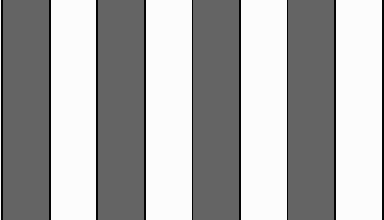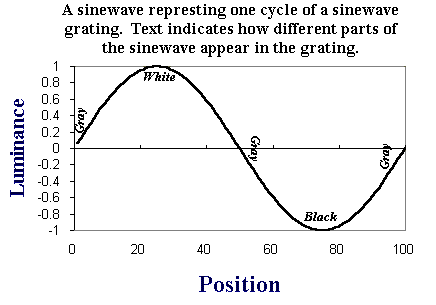

Basics of Gratings (sinewave and square-wave)


A grating is a repeating sequence of light and dark bars. One adjacent pair of a
light and a dark bar makes up one cycle. These cycles repeat over and over in a grating.
Typically, we think of these gratings as having sharp edges like the bars shown in Figure
1 below.
 Figure 1. A grating composed of black and white bars that
is typically called a square-wave grating.
Figure 1. A grating composed of black and white bars that
is typically called a square-wave grating.
These gratings have become known as square-wave gratings because they have
characteristics like a square such as sharp edges. This square-like nature of the light
levels (or luminance), as it falls across different positions along the surface of an
object can be seen in Figure 2. Clicking on Figure 2 will bring down the square-wave
grating so that you can more easily compare the actual grating to the graph of the
grating.
 Figure 2. A graph of the luminance of
a square-wave as a function of position for one cycle.
Figure 2. A graph of the luminance of
a square-wave as a function of position for one cycle.
However, there is no reason that light has to vary in a square-wave fashion. What if
the light varied in a sinewave fashion? Figure 3 shows one cycle of a sinewave. Clicking
on Figure 3 will bring down a sinewave grating with four cycles just as Figure 1 showed a
square-wave grating with four cycles.
 Figure 3. A graph of the luminance of a
sinewave as a function of position for one cycle.
Figure 3. A graph of the luminance of a
sinewave as a function of position for one cycle.
 Click here to return to the beginning of this tutorial.
Click here to return to the beginning of this tutorial.